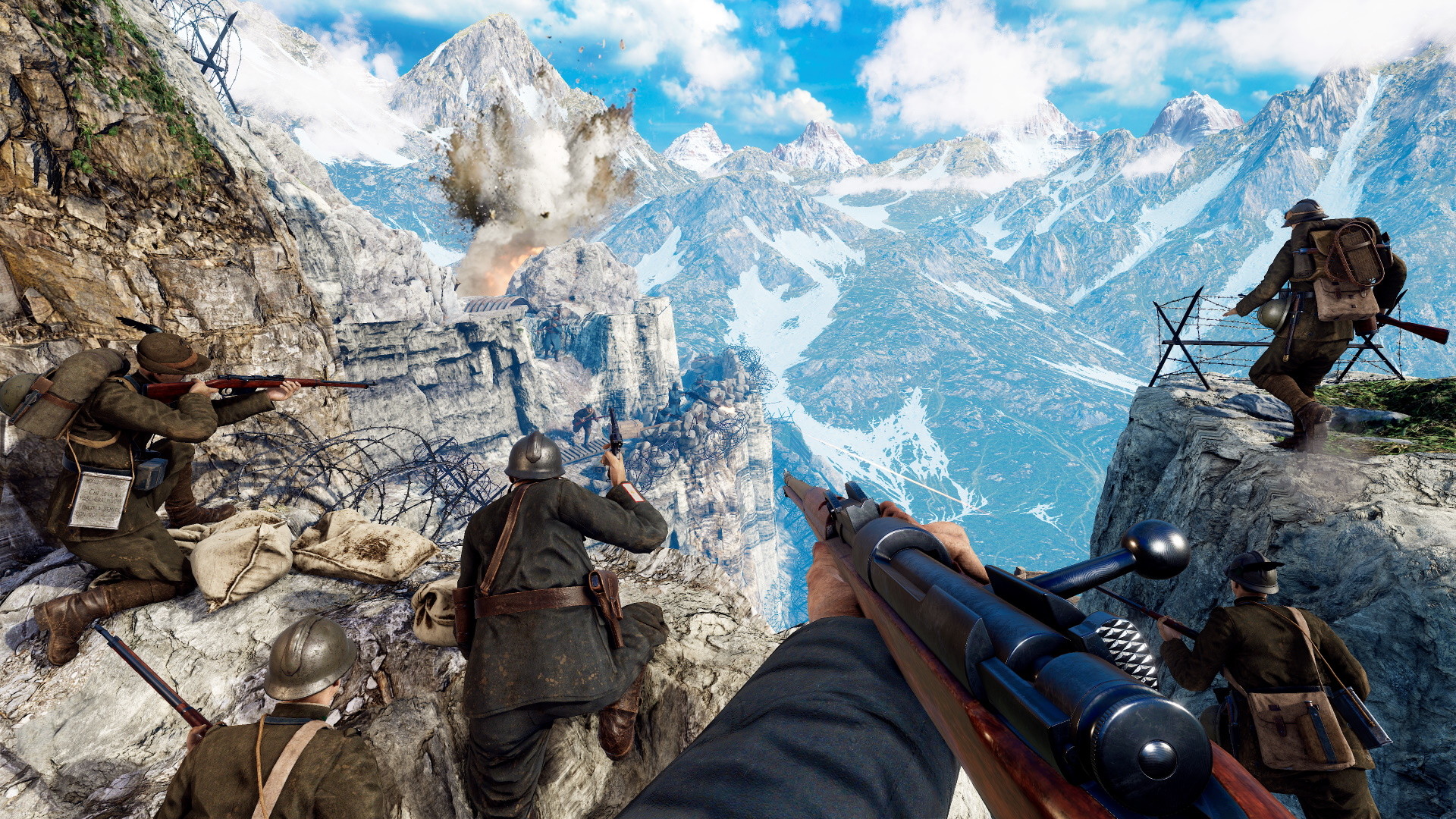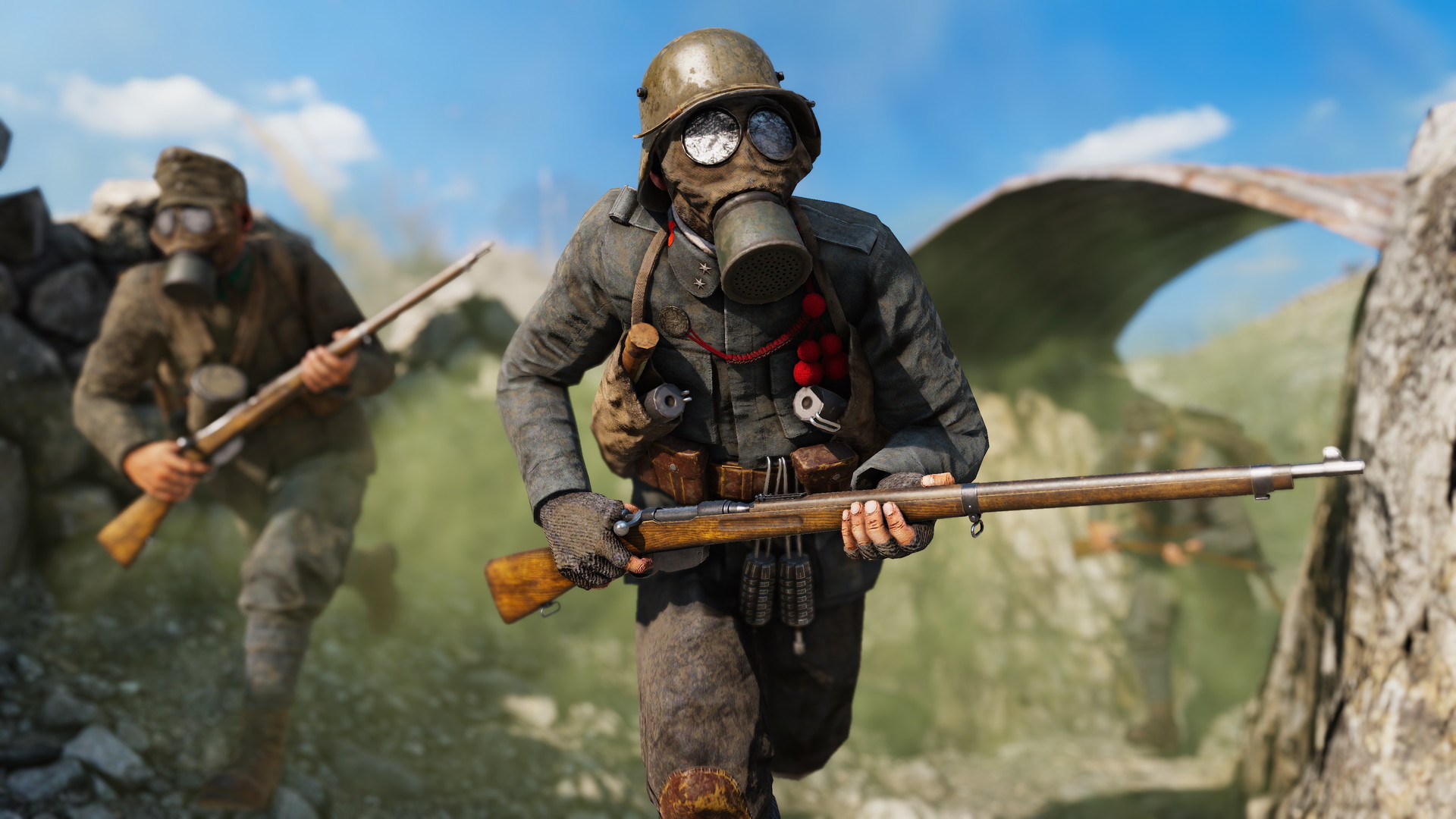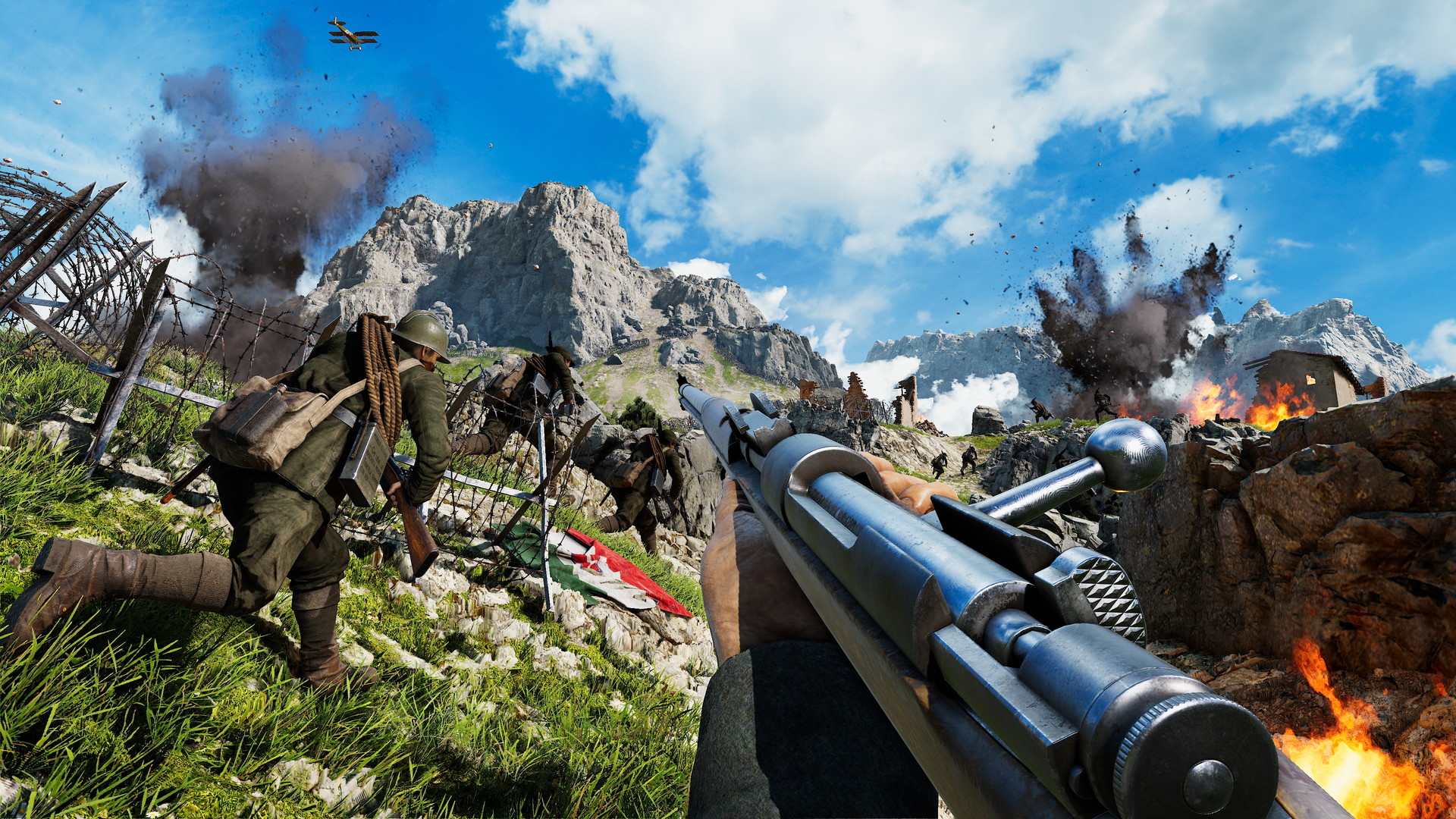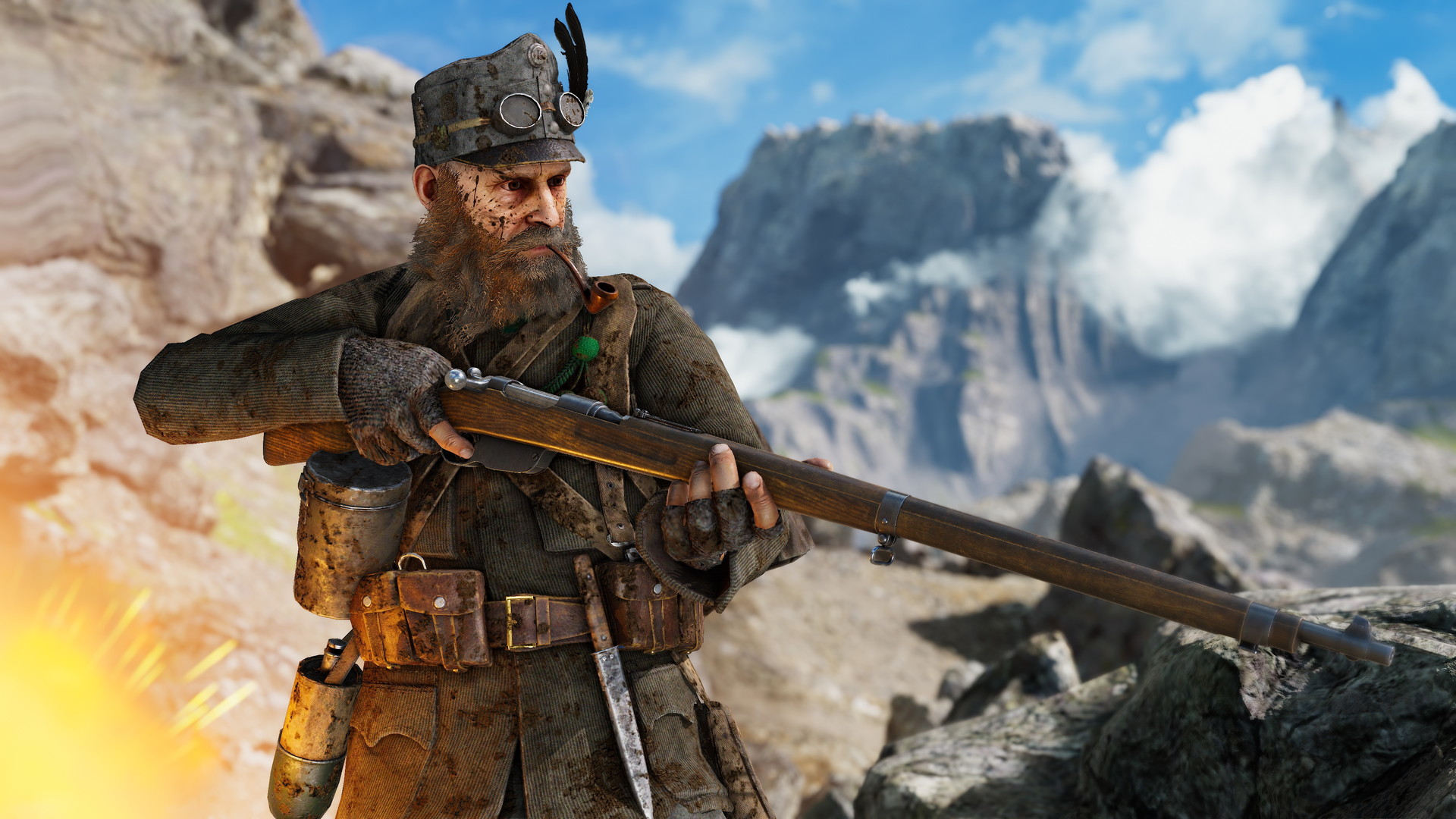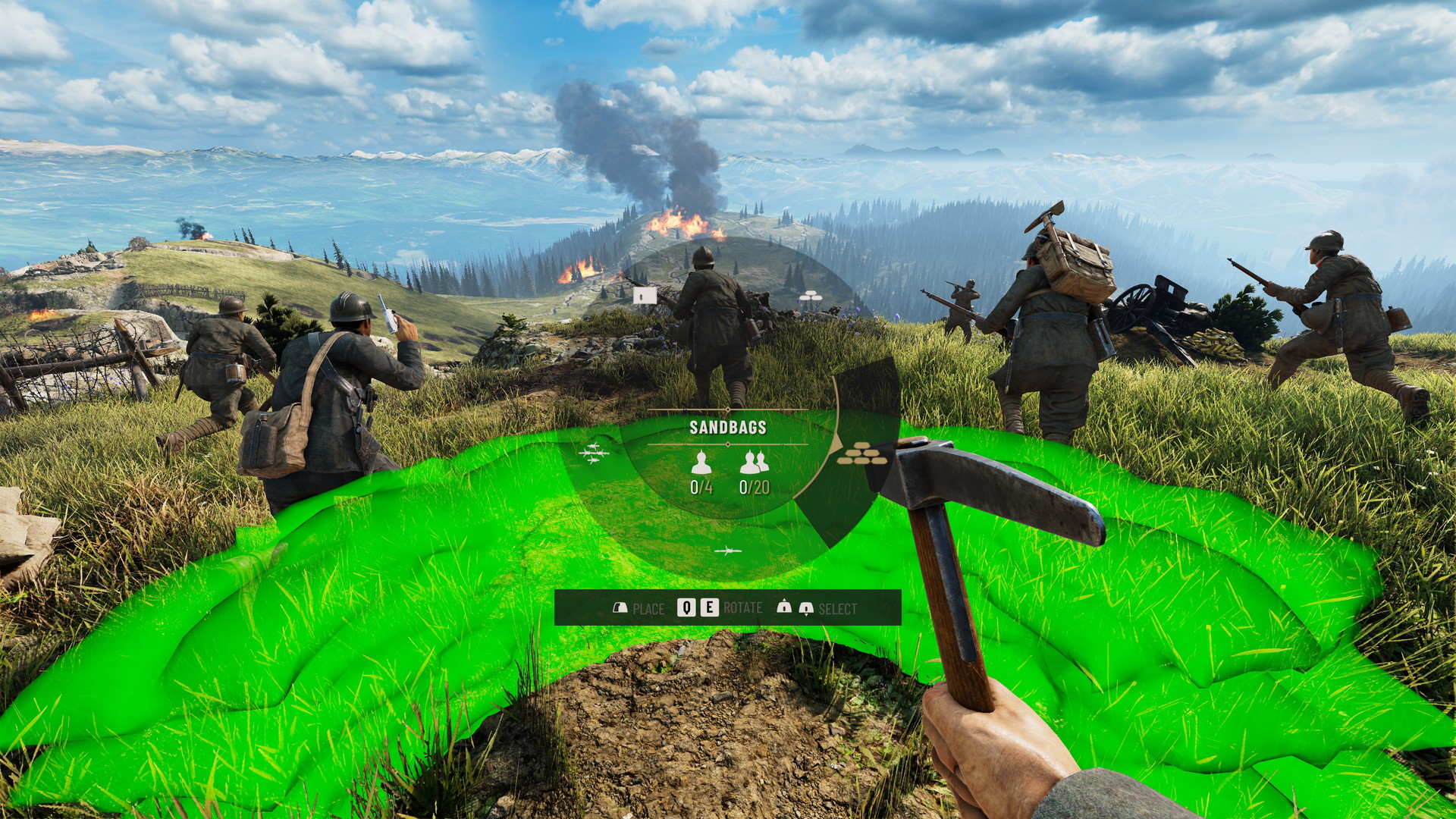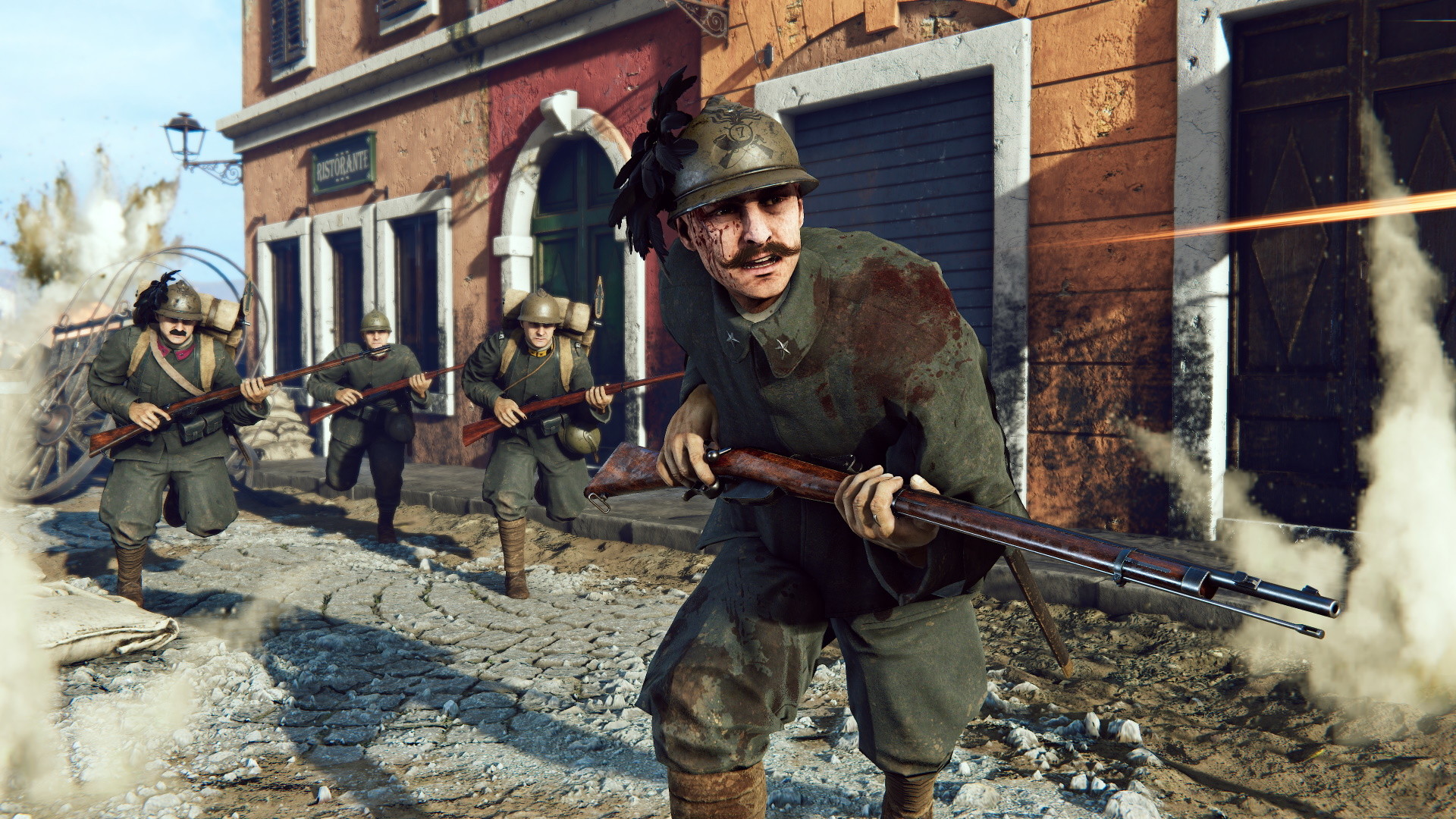World War One expands to the mountains of the Italian Front - beautiful but deadly in equal measure. Inspired by the two year struggle for control of the Isonzo river valley and the Alps during World War One, Isonzo elevates the WW1 Games Series, figuratively and literally.
From the makers of Verdun and Tannenberg …
The new Offensive game mode puts you right in the middle of key historical offensives on the Italian Front. Lead the charge across stunning Italian landscapes as you choose your path to victory - cut paths through barbed wire, flank your enemies by following mountain trails, or man a mortar to blast a way through. Shape a dynamic battlefield by laying sandbags and wire, placing ammo crates, deploying trench periscopes or sniper shields, and more.

Take part in historical offensives from the Sixth Battle of the Isonzo to the Strafexpedition. Reflecting the course of the actual battles, as the attackers advance the fighting will shift through vastly different landscapes within a single offensive: from hillside fortresses to mountain trenches and fierce urban combat on city streets. Everything is recreated based on research and field trips, from sound effects and uniforms down to the houses, vineyards and trenches you’ll be fighting over.
Call in support with a unique historically accurate flare system: flare guns can mark targets for artillery or biplane flybys, or different colored flares can be used to guide your team. Once the big guns have softened up the enemy, finish the job at close quarters with an Arditi dagger or mountaineer’s pickaxe. Man heavy machine guns, mortars and even mountain guns for more direct fire support.

Choose from six classes based on historical combat roles and build your loadout from a selection of weapons, equipment and perks linked to that class, giving flexibility and variety while staying grounded in what real soldiers might have carried. You’ll be operating wire cutters, bandaging yourself and wounded teammates, and blowing the whistle to start an assault. One shot can kill and even lighter injuries can lead to quickly bleeding out.
Being an effective soldier in Isonzo is not just about being a good marksman. Mastering the terrain is also key - the mountain can be a friend or foe. Learn how to navigate well to maintain cover and surprise your enemies or support your allies.
Finally… watch out for the dreaded poison gas. You’ve never experienced WW1 action quite like this!
Isonzo key features include:
More Games in the Authentic WW1 Game Series
Immerse yourself in more WW1 action with our other standalone titles Tannenberg and Verdun. Experience trench warfare on the Western Front in Verdun, or maneuver for control of key sectors in Tannenberg on the Eastern Front. These authentic WW1 shooters let players choose from a range of squads from across the war, as they fight for control of the ever-changing frontlines.
From the makers of Verdun and Tannenberg …
The new Offensive game mode puts you right in the middle of key historical offensives on the Italian Front. Lead the charge across stunning Italian landscapes as you choose your path to victory - cut paths through barbed wire, flank your enemies by following mountain trails, or man a mortar to blast a way through. Shape a dynamic battlefield by laying sandbags and wire, placing ammo crates, deploying trench periscopes or sniper shields, and more.

Take part in historical offensives from the Sixth Battle of the Isonzo to the Strafexpedition. Reflecting the course of the actual battles, as the attackers advance the fighting will shift through vastly different landscapes within a single offensive: from hillside fortresses to mountain trenches and fierce urban combat on city streets. Everything is recreated based on research and field trips, from sound effects and uniforms down to the houses, vineyards and trenches you’ll be fighting over.

Call in support with a unique historically accurate flare system: flare guns can mark targets for artillery or biplane flybys, or different colored flares can be used to guide your team. Once the big guns have softened up the enemy, finish the job at close quarters with an Arditi dagger or mountaineer’s pickaxe. Man heavy machine guns, mortars and even mountain guns for more direct fire support.

Choose from six classes based on historical combat roles and build your loadout from a selection of weapons, equipment and perks linked to that class, giving flexibility and variety while staying grounded in what real soldiers might have carried. You’ll be operating wire cutters, bandaging yourself and wounded teammates, and blowing the whistle to start an assault. One shot can kill and even lighter injuries can lead to quickly bleeding out.
Being an effective soldier in Isonzo is not just about being a good marksman. Mastering the terrain is also key - the mountain can be a friend or foe. Learn how to navigate well to maintain cover and surprise your enemies or support your allies.
Finally… watch out for the dreaded poison gas. You’ve never experienced WW1 action quite like this!
Isonzo key features include:
- Mountain warfare: Assaulting mountain fortifications, battling through ruined towns, and fording rivers are just a few of the challenges you’ll face as you fight your way through numerous enemy positions
- Tactical multiplayer FPS: Choose your role and loadout carefully to survive this high altitude combat - play a sniper to pick off the enemy engineers before they can cut your wire, use rifle grenades to clear enemy machine guns, and much more
- World War One Gameplay: Historical Offensive game mode based on real battles and focused on the unique challenges of Alpine warfare. Fight with 30+ WW1 weapons, poisonous gas attacks, and intense artillery barrages
- Build for victory: Place your own wire, sandbags, trench periscopes, and more! Whether you’re digging in or on the attack, shaping the battlefield to your advantage will be key to victory
- Faces of war: Make every class your own by picking from a variety of historically class-appropriate uniforms, accessories and headgear. As a finishing touch, you can even pick your mustache from several famous period-accurate styles!
- Authentic WW1 atmosphere: Accuracy in everything from maps and weaponry to music and the uniforms – fight for the Kingdom of Italy or the Austro-Hungarian Dual Monarchy

More Games in the Authentic WW1 Game Series
Immerse yourself in more WW1 action with our other standalone titles Tannenberg and Verdun. Experience trench warfare on the Western Front in Verdun, or maneuver for control of key sectors in Tannenberg on the Eastern Front. These authentic WW1 shooters let players choose from a range of squads from across the war, as they fight for control of the ever-changing frontlines.
Devblog #43 - The German Assault Class
During World War One, Germany (and other nations) made use of assault troops, building a certain reputation for it. They would be fielding minimal equipment, armed with grenades and light rifles/pistols. In 1918 submachine guns were added to their loadout. The stormtroopers were made up of well-trained & experienced soldiers led by largely autonomous decision-making commanders. Their expertise and role was to break the impasse of trench warfare. Known as; mobile, ruthless, and effective - these troops are prevalent in WW1 imagery to this day.

The Stotruppen in Isonzo showcase some classic characteristics you might know. Some of these are; the reinforced leather knee patches, grenades worn on the belt, grenade bags/chest plate, the gas mask worn at a readied position for immediate access. This all contributed to a general lighter kind of equipment, which we mentioned earlier. Additionally, it wasnt uncommon to see them with a trench dagger, like many assault forces during the war.
Lets take a closer look at some of their equipment items!
The concept of the grenade was not something new during WW1, as it has been around for centuries. Prior to the Great War, it wasnt an especially popular and effective piece of military equipment. With the introduction of Trench Warfare, the grenade became an increasingly apparent item.
The grenade was a useful tool for clearing entrenched positions such as bunkers and dugouts. Its efficiency for this purpose provided the standard infantry man a form of mobile light artillery. Its design changed and adopted during this new worldwide conflict and type of warfare it was now used in.
The grenade effectively gave the standard infantryman a form of mobile light artillery, and the designs adopted during the conflict borrowed many features from their predecessors.

Portable, powerful, simple, and easy to use the German stick grenade would become intertwined with World War One imagery.
Appearing first in 1915, the stick grenade was a concussive blast grenade (unlike the French F1 and British Mills bomb) which didnt always kill but would often stun opponents instead. The shape of the grenade was ideal for throwing and the short fuse made it a difficult weapon to avoid for the enemy.
Made out of a wooden handle, grenade head and fuse, it came with a hook on the grenade head making it carriable on the belt. Its shape made it quite safe to use accurately, as it was less likely to roll, compared with the rounder hand grenades of the period.

A faulty element of the original 1915 grenade was the pull cord located at the base, which could lead to accidental triggers. Therefore the new 1916 design introduced a small screw cap, which hid the cord (with a porcelain bead) safely located within the grenades wooden handle.
The German grenades came with a variety of different heads such as our M16 variant, which has the older Brennznder 15 style grenade head. The M17 design in general was more streamlined and had a smaller grenade head. This was due to the more powerful explosive Trinitrotoluene that was used in these models.
Famous through both the First and Second World Wars, many variants of this simple design would be adopted throughout the years by multiple nations though eventually the smaller compact style of the F1/Mills style grenade design eventually took over.
Further adding to the German arsenal is the M17 Eierhandgranate (literally meaning egg hand grenade). Although the stick grenades showed their effectiveness on the battlefield, the German forces recognized a need for other grenade types. This led to the introduction of several small grenade designs that resemble a hens egg, hence the name. The n/A (Neuer Art / new model) improved on earlier models which were entirely smooth - not ideal for handling in the wet and mud that characterized many World War One battlefields.

This small grenade proved to be extremely portable but underpowered compared with the Stielhandgranate. It is not uncommon to see German troops with a plate worn on the chest for quick grenade usages. Effective in offensives, it was especially popular with assault roles. Photographs of this are rare as the grenades were often conveniently housed in a tunic pocket.

4th and 5th soldier holding an egg hand grenade and plate
In 2017, we discovered this unearthed grenade during our trip to Fort Douaumont, which is near Verdun. With the grenade head of an older style M15 we made sure we didnt touch it!

It was most likely an unwelcome, but unsurprising discovery by someone metal detecting.
It has gotten cold on the Eastern Front. The winter and snow have made it a difficult terrain for the soldiers to battle on. However, theyre not the only ones being affected by the cold season and the war. Like a soldier, the wolf awaits his moment to attack his prey in the woods...
Starting today until November 28, you can participate in the Wolf Truce in Tannenberg! Hold the truce and obtain a special medal!

https://store.steampowered.com/app/633460/Tannenberg/
Hello soldiers!
Thank you all for your participation during the Armistice Day silence. We loved seeing and reading your comments in Discord as well.
Additionally, we shared a devblog about the German rifle . We would like to continue this trend and shed some light on a different German class for this week.
The German Assault - Stotrupp
During World War One, Germany (and other nations) made use of assault troops, building a certain reputation for it. They would be fielding minimal equipment, armed with grenades and light rifles/pistols. In 1918 submachine guns were added to their loadout. The stormtroopers were made up of well-trained & experienced soldiers led by largely autonomous decision-making commanders. Their expertise and role was to break the impasse of trench warfare. Known as; mobile, ruthless, and effective - these troops are prevalent in WW1 imagery to this day.

The Stotruppen in Isonzo showcase some classic characteristics you might know. Some of these are; the reinforced leather knee patches, grenades worn on the belt, grenade bags/chest plate, the gas mask worn at a readied position for immediate access. This all contributed to a general lighter kind of equipment, which we mentioned earlier. Additionally, it wasnt uncommon to see them with a trench dagger, like many assault forces during the war.
Lets take a closer look at some of their equipment items!
Look out! Grenade!
The concept of the grenade was not something new during WW1, as it has been around for centuries. Prior to the Great War, it wasnt an especially popular and effective piece of military equipment. With the introduction of Trench Warfare, the grenade became an increasingly apparent item.
The grenade was a useful tool for clearing entrenched positions such as bunkers and dugouts. Its efficiency for this purpose provided the standard infantry man a form of mobile light artillery. Its design changed and adopted during this new worldwide conflict and type of warfare it was now used in.
The grenade effectively gave the standard infantryman a form of mobile light artillery, and the designs adopted during the conflict borrowed many features from their predecessors.

Stielhandgranate
Portable, powerful, simple, and easy to use the German stick grenade would become intertwined with World War One imagery.
Appearing first in 1915, the stick grenade was a concussive blast grenade (unlike the French F1 and British Mills bomb) which didnt always kill but would often stun opponents instead. The shape of the grenade was ideal for throwing and the short fuse made it a difficult weapon to avoid for the enemy.
Made out of a wooden handle, grenade head and fuse, it came with a hook on the grenade head making it carriable on the belt. Its shape made it quite safe to use accurately, as it was less likely to roll, compared with the rounder hand grenades of the period.

A faulty element of the original 1915 grenade was the pull cord located at the base, which could lead to accidental triggers. Therefore the new 1916 design introduced a small screw cap, which hid the cord (with a porcelain bead) safely located within the grenades wooden handle.
The German grenades came with a variety of different heads such as our M16 variant, which has the older Brennznder 15 style grenade head. The M17 design in general was more streamlined and had a smaller grenade head. This was due to the more powerful explosive Trinitrotoluene that was used in these models.
Famous through both the First and Second World Wars, many variants of this simple design would be adopted throughout the years by multiple nations though eventually the smaller compact style of the F1/Mills style grenade design eventually took over.
Eierhandgranate M17
Further adding to the German arsenal is the M17 Eierhandgranate (literally meaning egg hand grenade). Although the stick grenades showed their effectiveness on the battlefield, the German forces recognized a need for other grenade types. This led to the introduction of several small grenade designs that resemble a hens egg, hence the name. The n/A (Neuer Art / new model) improved on earlier models which were entirely smooth - not ideal for handling in the wet and mud that characterized many World War One battlefields.

This small grenade proved to be extremely portable but underpowered compared with the Stielhandgranate. It is not uncommon to see German troops with a plate worn on the chest for quick grenade usages. Effective in offensives, it was especially popular with assault roles. Photographs of this are rare as the grenades were often conveniently housed in a tunic pocket.

4th and 5th soldier holding an egg hand grenade and plate
A battlefield find!
In 2017, we discovered this unearthed grenade during our trip to Fort Douaumont, which is near Verdun. With the grenade head of an older style M15 we made sure we didnt touch it!

It was most likely an unwelcome, but unsurprising discovery by someone metal detecting.
Howling heard on the Eastern Front
It has gotten cold on the Eastern Front. The winter and snow have made it a difficult terrain for the soldiers to battle on. However, theyre not the only ones being affected by the cold season and the war. Like a soldier, the wolf awaits his moment to attack his prey in the woods...
Starting today until November 28, you can participate in the Wolf Truce in Tannenberg! Hold the truce and obtain a special medal!

https://store.steampowered.com/app/633460/Tannenberg/
See you next week, soldiers!
[ 2022-11-18 13:32:12 CET ] [Original Post]
Minimum Setup
- OS: Requires a 64-bit processor and operating system
- Processor: Intel Core 2 Quad Q9550Memory: 4 GB RAM
- Memory: 4 GB RAM
- Graphics: NVIDIA GeForce GT 640
- Storage: 20 GB available space
Recommended Setup
- OS: Requires a 64-bit processor and operating system
- Processor: Intel i7-4770Memory: 16 GB RAM
- Graphics: NVIDIA GeForce GTX 1050
- Storage: 20 GB available space
GAMEBILLET
[ 6425 ]
GAMERSGATE
[ 3784 ]
MacGamestore
[ 2906 ]
FANATICAL BUNDLES
HUMBLE BUNDLES
by buying games/dlcs from affiliate links you are supporting tuxDB

